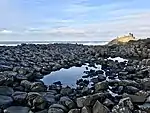Leitrim Group
The Leitrim Group is a lithostratigraphical term coined to refer to the succession of rock strata which occur in Northern Ireland within the Visean and Namurian stages of the Carboniferous Period.[1] The group disconformably overlies the Dartry Limestone of the Tyrone Group.
| Leitrim Group Stratigraphic range: Asbian to Arnsbergian, Carboniferous) | |
|---|---|
| Type | Group |
| Unit of | Carboniferous Limestone Supergroup |
| Sub-units | Lackagh Sandstone, Gowlaun Shale, Briscloonagh Sandstone, Dergvone Shale, Carraun Shale, Bellavally, Glenade Sandstone and Meenymore formations |
| Overlies | Tyrone Group |
| Lithology | |
| Primary | sandstone |
| Other | mudstone, conglomerate, shale, limestone, siltstone, breccia |
| Location | |
| Country | Northern Ireland |
| Extent | County Fermanagh, County Tyrone |
| Type section | |
| Named for | County Leitrim |
Stratigraphy
The group comprises a series of shales and sandstones which in stratigraphic order (youngest/uppermost at top) are:
Lackagh Sandstone Formation
The formation is 60-90m thick in the Connaught Coalfield but only about 36m thick on Cuilcagh Mountain where it forms the prominent cliff-edged summit surface as also at Belmore.[2] It is unfossiliferous.
Gowlaun Shale Formation
Some 50-60m thickness of shales and mudstones of Arnsbergian age constitute this formation.
Briscloonagh Sandstone Formation
About 53m of Pendleian age sandstones with interlayered siltstones and some mudstone make up this formation.
Dergvone Shale Formation
Mostly dark coloured iron-rich shales of Pendleian age, it reaches up to 128m thick. From its top downwards, it is divided into the Lacoon Sandstone, Killooman Shale, Tonlegee Shale, Tullyclevaun Shale, Black Mountain Shales and Gubaveeny Shale members.
Carraun Shale Formation
From 50m to over 160m thick, this Brigantian age formation is largely shale but contains thin limestones, siltstones and sandstones, some of which are given their own names as members e.g. the Doagh Limestone and Tawnyunshinagh Limestone members.
Bellavally Formation
This Asbian to Brigantian age formation varies from 45m to 80m thick and consists largely of sandstones and shales with lesser amounts of siltstone and limestone. From its top downwards, it is divided into the Corry, Sheena Shale, Glenkeel, Doobally Sandstone, Drummangarvagh, Lugasnaghta, Sraduffy, Larkfield and Tullyskeherny members.
Glenade Sandstone Formation
Referred to as the Yoredale Sandstone in the late nineteenth century, this Asbian age sequence varies from 4m thick in County Leitrim to as much as 350m in the north of its range. In places it sits directly on the Dartry Limestone where the Meenymore Formation rocks are missing due to the locally high relief of the underlying erosive surface. Animal fossils are almost wholly absent from this formation though fragments of Calamites and leaf remains are more common.
Meenymore Formation
The lowermost and hence oldest division of the Group is of Asbian age. It comprises mudstones and limestones and delta sandstones, two of which are mapped as separate ‘members’; the Glen and Quarry Sandstone, the former only being seen west of the Glen Syncline. The thickness of the formation varies from 18m at Doagh to 100m to the east of Cuilcagh Mountain. A depositional hiatus separates this formation from the underlying Dartry Limestone.
References
- https://www.bgs.ac.uk/lexicon/lexicon.cfm?pub=LEG BGS Lexicon of named rock units
- Marble Arch Caves Global Geopark; Exploring the landscape of Fermanagh and Cavan (map), 2015 GSNI ISBN 9780751837933
- I.C. Legg, T.P Johnston, W.I. Mitchell & R.A. Smith (1998). Geology of the country around Derrygonnelly and Marble Arch, Memoir of the Geological Survey of Northern Ireland, Sheet 44, 56 and 43 (Northern Ireland) (1. ed.). London: The Stationery Office. pp. 26–50. ISBN 0118845314.CS1 maint: multiple names: authors list (link)
